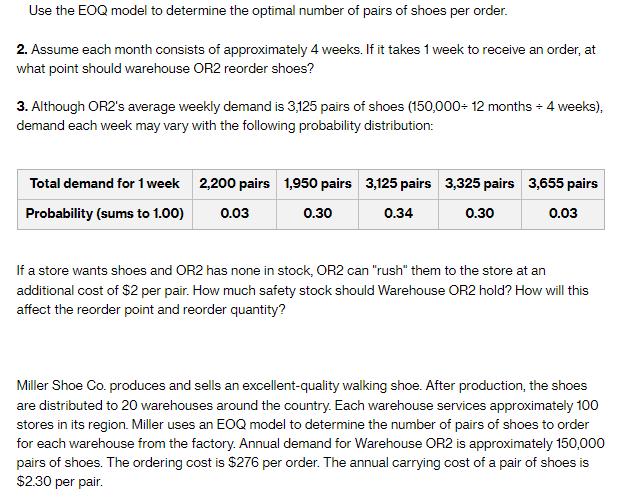Answered step by step
Verified Expert Solution
Question
1 Approved Answer
Use the EOQ model to determine the optimal number of pairs of shoes per order. 2. Assume each month consists of approximately 4 weeks.

Use the EOQ model to determine the optimal number of pairs of shoes per order. 2. Assume each month consists of approximately 4 weeks. If it takes 1 week to receive an order, at what point should warehouse OR2 reorder shoes? 3. Although OR2's average weekly demand is 3,125 pairs of shoes (150,000+ 12 months + 4 weeks), demand each week may vary with the following probability distribution: Total demand for 1 week Probability (sums to 1.00) 2,200 pairs 1,950 pairs 3,125 pairs 3,325 pairs 3,655 pairs 0.03 0.30 0.34 0.30 0.03 If a store wants shoes and OR2 has none in stock, OR2 can "rush" them to the store at an additional cost of $2 per pair. How much safety stock should Warehouse OR2 hold? How will this affect the reorder point and reorder quantity? Miller Shoe Co. produces and sells an excellent-quality walking shoe. After production, the shoes are distributed to 20 warehouses around the country. Each warehouse services approximately 100 stores in its region. Miller uses an EOQ model to determine the number of pairs of shoes to order for each warehouse from the factory. Annual demand for Warehouse OR2 is approximately 150,000 pairs of shoes. The ordering cost is $276 per order. The annual carrying cost of a pair of shoes is $2.30 per pair.
Step by Step Solution
★★★★★
3.41 Rating (154 Votes )
There are 3 Steps involved in it
Step: 1
To determine the optimal number of pairs of shoes per order using the Economic Order Quantity EOQ model we need to calculate the EOQ and the reorder p...
Get Instant Access to Expert-Tailored Solutions
See step-by-step solutions with expert insights and AI powered tools for academic success
Step: 2

Step: 3

Ace Your Homework with AI
Get the answers you need in no time with our AI-driven, step-by-step assistance
Get Started


